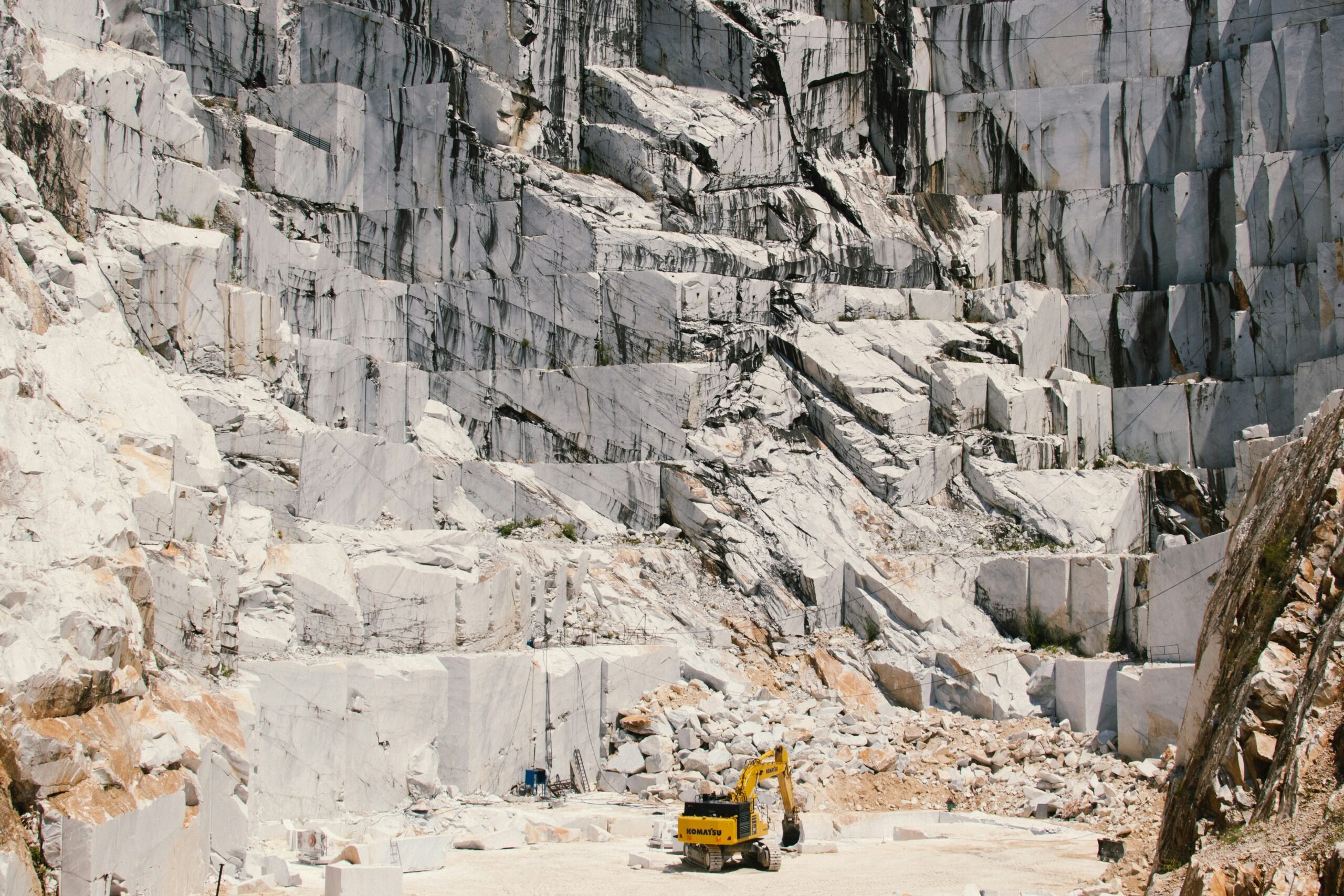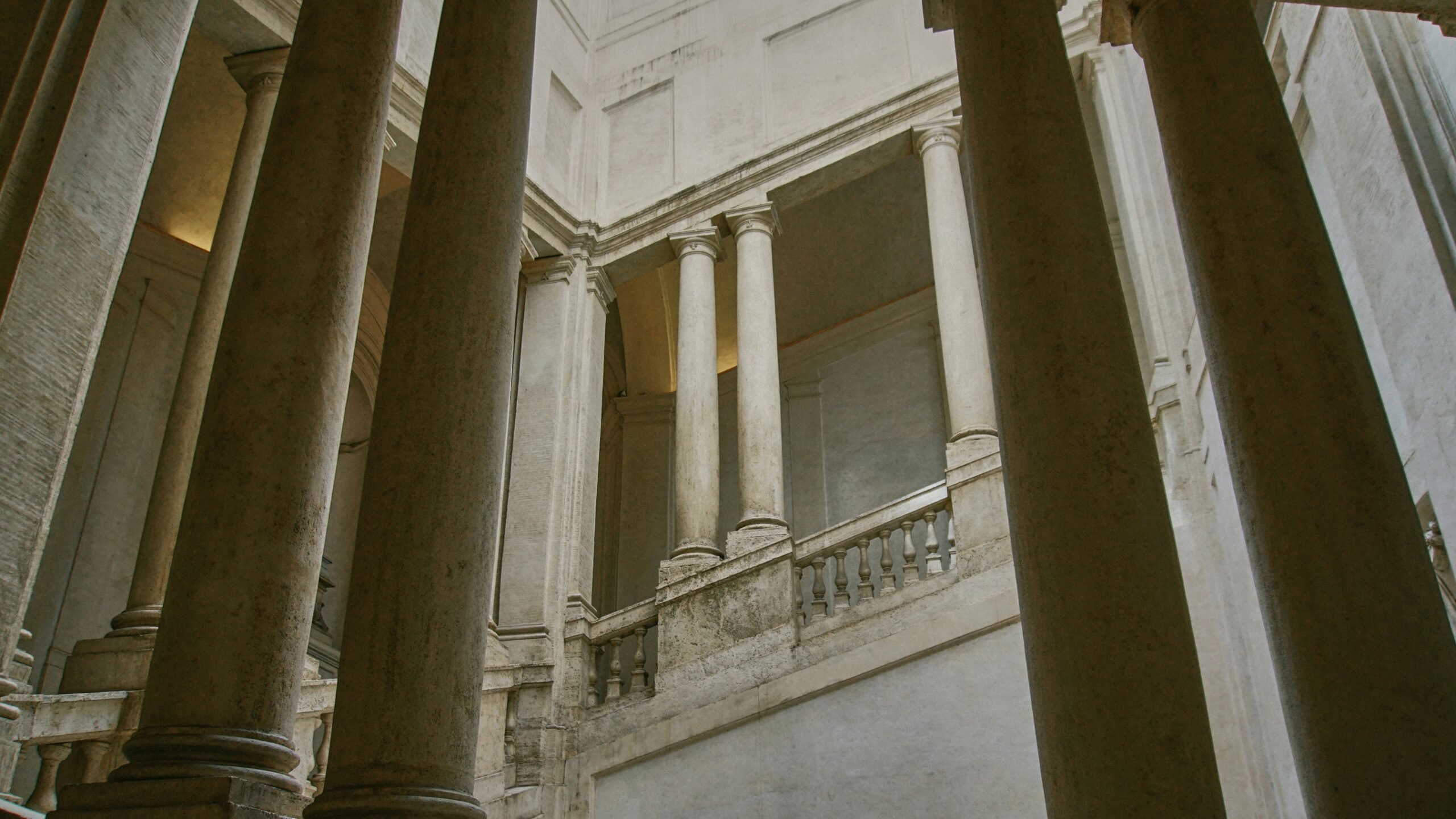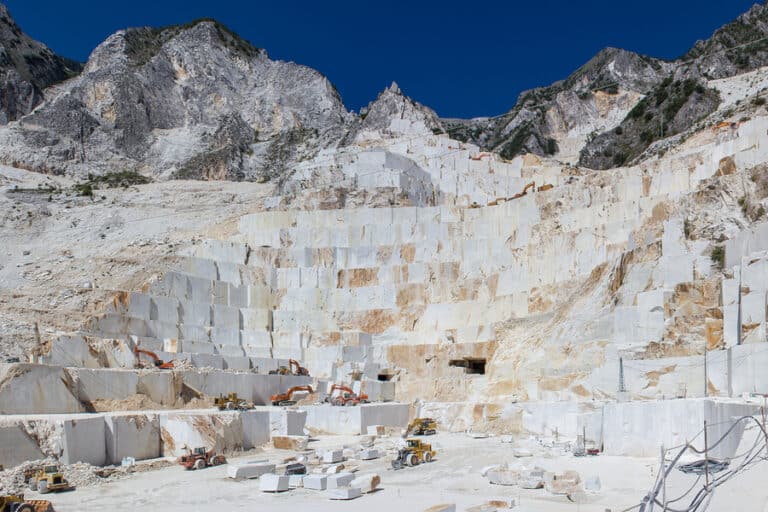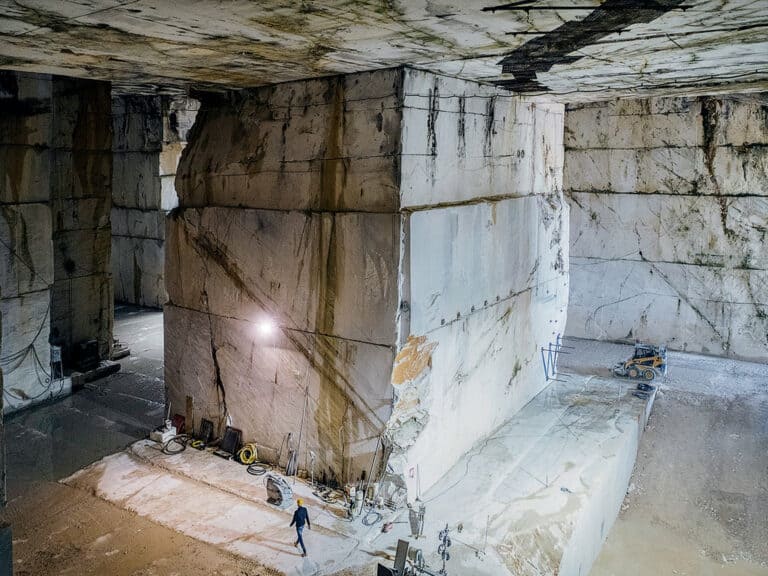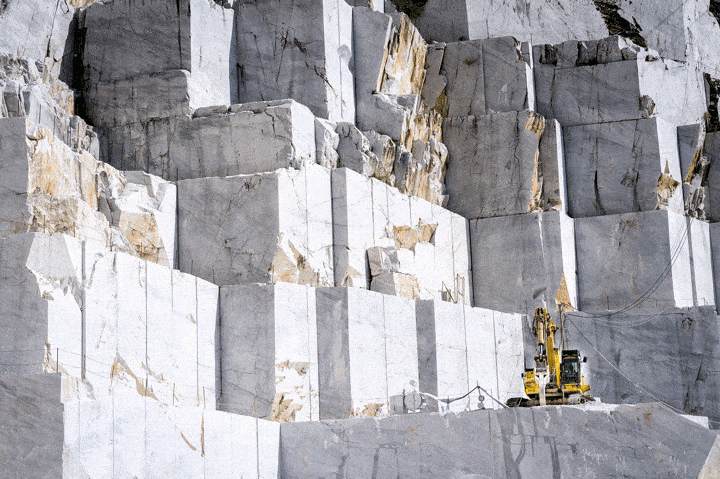Carrara Marble vs. Calacatta Marble
Few construction and interior design materials stand up to the beauty and elegance offered by marble.
In particular, two of the most distinct varieties of this special natural stone are Carrara Marble and Calacatta Marble. Being two of the most sought-after types of stone and seeing as they are similarly named, it is not surprising that they are confused with one another.
We’ve put together this handy guide to help clarify the differences and distinctiveness between Carrara and Calacatta Marble. From aesthetics and source of origin to durability and functionality, by the end of this article, you’ll be able to make an informed decision as to which of these fantastic options best suits your needs.
The Source of Marble
Interestingly, but confusingly, both Carrara and Calacatta Marble are found in the Carrara region of Tuscany, Italy. This area has been used as a quarry for literally centuries–at least since the days of ancient Rome.
Nevertheless, there are individual quarries within this geographical location and each one offers unique marble with distinct characteristics. Carrara Marble is the more commonly found and available of the two. This makes it more affordable generally than its sister marble.
Calacatta Marble is rarer, even in the region, and this exclusivity coupled with global demand adds to both its cost but also its appeal.
The Visual Aesthetic
Perhaps the most distinguishing feature between Carrara and Calacatta Marble is aesthetic appearance. If you look closely at the two slabs side by side, you will notice differences to both their colours and veining patterns.
Carrara Marble
Carrara Marble features softer and more subtle veining patterns. Its general shade is more off-white and sometimes even a light grey with gentle undertones and striations of blue-grey colouring. The veins themselves are slightly darker than the background colouring, almost a light or water grey that seems to dissipate naturally into the rest of the stone.
Calacatta Marble
Calacatta Marble is bolder. Its veining is far more dramatic and is often thick and easily aesthetically defined. The stone itself is brighter than even white Carrara Marble which only serves to contrast more with the darker grey veining. Sometimes, the veining can even be brown or gold, depending on the variety.
Durability and Maintenance
Both Carrara Marble and Calacatta Marble have similar levels of durability and maintenance. Comparatively, marble is a porous material by natural stone standards. This means that it requires regular sealing to prevent staining, scratching and etching. Acidic substances in particular can damage the surface of the stone, so swift cleaning of spills is critical for best maintenance.
However, marble is still hardy and durable as a material. With proper care and some simple, consistent maintenance, you can ensure both the longevity and aesthetic quality of your marble.
Overall, Calacatta Marble is often less porous than Carrara Marble and will require resealing slightly less frequently. Similarly, its denser composition also makes it slightly more resistant to scratches, etching and damage.
How to Take Care of Your Marble
To begin with, as mentioned above, sealing your marble stone is important for ensuring it is protected from liquids and staining. A simple test you can run is to drop a small amount of water onto the stone surface. If the droplets do not bead up, we recommend you consider resealing.
When you do spill something, always make sure you clean it up as quickly as possible. Blot instead of wipe to ensure you don’t actually cause the liquid to spread more.
General cleaning can be done with gentle, soft cloths and using pH-neutral cleaners that are not acidic and designed specifically for marble.
Last but not least, always use mats or other protective items when placing hot dishes, pans and pots so that the intense heat from the utensil does not damage the marble itself.
Functionality and Application
Both Carrara and Calacatta Marble can and are used in a wide range of home design and construction applications. These include everything from kitchen benchtops and flooring to vanities and wall cladding.
But there are subtle differences in best practice application.
Where Carrara Marble Works Best
Carrara Marble is often used for areas of the house that don’t see such heavy traffic. This is not just a reflection of the material itself but its softer veining and more subtle aesthetic quality makes it much easier to blend seamlessly into the rest of the home design scheme. In other words, you can use Carrara Marble over large expanses of surfaces, such as walls and floors, without risking overpowering that space.
Where Calacatta Marble Works Best
On the other hand, Calacatta Marble is more often preferred for areas where you want more dramatic flair. Thanks to its bold veining patterns and more glamorous and luxurious appearance, it is more suitable for feature areas. While you certainly can use Calacatta Marble in large quantities, it also makes for excellent use in smaller, focused amounts such as a fireplace or countertop.
How to Use Your Chosen Marble
At the end of the day, you can’t really go wrong with marble. It looks fantastic. It works great. It’s classic and classy, beautiful and functional.
But if you press us for an opinion, we recommend Carrara Marble for homeowners wanting a more natural-looking and softer aesthetic. Plus, it is often more affordable so it can be more practical for many people.
If bold and stunning is the look you are after, we recommend Calacatta Marble. This sophisticated natural stone can glamour-up any space in which it is used and will catch the eye of family, friends, guests and visitors alike.
Choose the Perfect Marble with Euro Marble
Whether it's Carrara or Calacatta, our experts are here to help you find the ideal marble for your project.
Why Italian Marble Is the Finest Marble in The World
Natural stone has earned a unique reputation as a high quality, highly popular choice of design and construction material;, and amongst varieties of marble, Italian marble has garnered a following even more so.
Why is Italy widely recognised as the home of some of the finest and most luxurious marble in the world? What makes it different from marble quarried in other countries?
Let’s dive right into it: What makes Italian marble the finest stone in the world?
Exploring the World of Italian Marble
Italian marble is a highly sought after building material for use both externally and internally. It has a well-deserved reputation for unparalleled quality and unique visual appeal. Throughout the world, Italian marble remains highly sought after and highly popular.
A Brief History
Of course, you may recall that iconic Renaissance artists such as Michelangelo and Donatello used Italian marble in their sculptures. Michelangelo’s extraordinary “David”, for example, utilised two forms of white marble: Calacatta and Statuario.
But Italian marble has been a preferred type of natural stone beyond just works of art. Thanks to its durability, its aesthetic distinctiveness and its usefulness, structures, buildings and facades have used marble for centuries. The Vatican, famously, uses marble generously throughout its museum displays and its building structures. It’s also widely used in wall cladding and interior flooring applications in ancient structures throughout history.
The question remains: Aside from beauty, does Italian marble live up to the hype? The answer is yes. Luxurious marble is an exceptional stone; it is pretty unmatched when it comes to durability. Apart from its luxury aesthetic indicating status and sophistication, it is a relatively hardy material which makes it all the more appealing for use in construction and interior design.
But there is another component here as well. Italy has a long-standing tradition of stone work. Italian artisans pioneered many of the quarrying techniques that are still used in the modern world today. Thanks to their high standard of craftsmanship and penchant for both quality and precision, the Italians have earned a glowing reputation right beside their natural source of marble.
What Makes Italian Marble More Durable than Other Types
Why is Italian marble so much more durable than other types? Well, there are actually a few factors.
1. Quality of the Raw Materials
Where is Italian marble from? (And don’t say Italy!)
One of the most popular quarries is located in the Carrara region. The reason this area has become so popular is that the marble found there is amongst the naturally purest in the world.
Marble stone is formed in the Earth from intense heat and pressure. The specifics of this process determines just how pure the particular layer of stone is and the rock found in Carrara, as well as other regions of Italy, developed into strikingly white marble with minimal flaws. Hence its popularity and reputation.
2. Structure of Italian Marble
Carrying on the theme of marble formation, Italian marble has developed large and tightly-bound ‘crystals’ so to speak during its development under high heat and pressure. The tightly bound crystals have resulted in making the marble much harder and much more durable than its pre-existing forms of premium stones, i.e., limestone.
Additionally, this crystalline structure allows the marble stone to be polished into a high shine which is a popular look and has become iconic of the marble aesthetic.
3. Quality Control
Out of pride and over centuries of development, Italian quarries have implemented high standards of quality control in the selection, cutting and packaging of its marble. This attention to detail has ensured reliably exceptional quality.
There are a variety of techniques employed in this respect.
- Quarrying methods – Italian quarry workers developed flawless processes for extracting large blocks of marble without compromising purity or quality.
- Precision cutting – The next step, cutting and carving, is done using advanced tools and techniques that minimise waste and reduce the likelihood of slabs with defects sneaking under the radar.
- Rigorous criteria – As mentioned above, Italians have a strict set of criteria regarding aesthetic, quality and durability that all exported stone must meet.
- Customisation and innovation – The Italian artisans are rightfully proud of their beautiful marble and they have channeled that passion into mastering new and innovative ways of showcasing their wondrous natural stone, including not just quarrying techniques but polishing methods and the like.
Why Italian Marble is Expensive
The price of Italian marble really comes down to two main factors: Demand and supply.
On the demand side, being such a highly popular and fashionable choice of stone, its price is correspondingly high. There is simply more interest in Italian stone and its aesthetic appeal than current availability.
On the supply side of the equation, Italian marble–like all natural stone–is not produced in a factory. It is quarried directly from the ground, cut into slabs and then shipped around the world retaining its natural texture, aesthetic and quality. The cost of doing this can be higher than your cookie-cutter engineered stone or other forms of building material.
How to Clean Italian Marble
Marble, like other types of stone, is highly durable and hardy. But its natural texture can be damaged when exposed to intense heat, staining liquids and scratches or intense physical trauma.
White Italian marble in particular is more porous than some other stones, so it can be susceptible to etching from acids and other damaging items.
Fortunately, a good quality sealer that is professionally applied can effectively protect your Italian marble from everyday damage and preserve its aesthetic appeal. Aside from your once-every-few-years resealing, make sure you regularly wipe down your Italian marble with a warm, wet and soft cloth and avoid using harmful chemical cleaners.
Popular Varieties of Italian Marble
So, you’re now just as in love with Italian marble as we are! In that case, you may want to consider some of the more popular varieties if you’re struggling to choose from the many fantastic options.
Carrara Marble
Carrara marble is one of the most commonly quarried types, iconic for its natural beauty. It has an iconic blue-grey background and features rather fine linear striations. Also, importantly, its greater availability means it is also among the more affordable options.
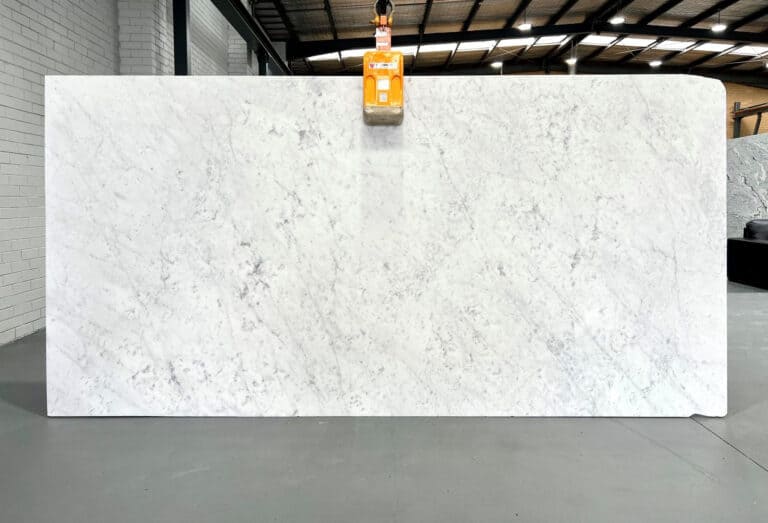
Calacatta Marble
Calacatta Marble is known for its rarity and instantly recognisable for its white marble luxurious aesthetic. It features that classic pure white background with dramatic shading and veining in gold, light brown or grey.
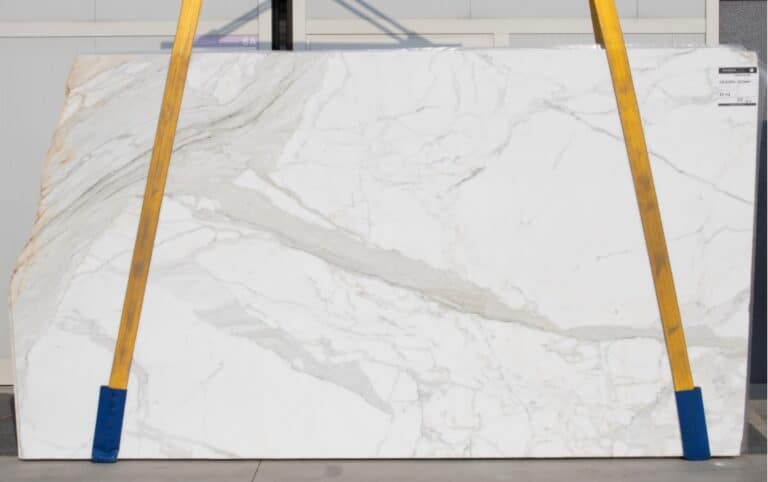
Statuario Marble
Statuario marble also boasts a white and bright colour but is known for its bold and visually appealing grey veining. This classic, timeless natural beauty is suitable for a range of applications. Due to the more limited supply and the unbalanced high demand for Statuario marble, it is generally a more expensive option to Carrara or Calacatta marble.
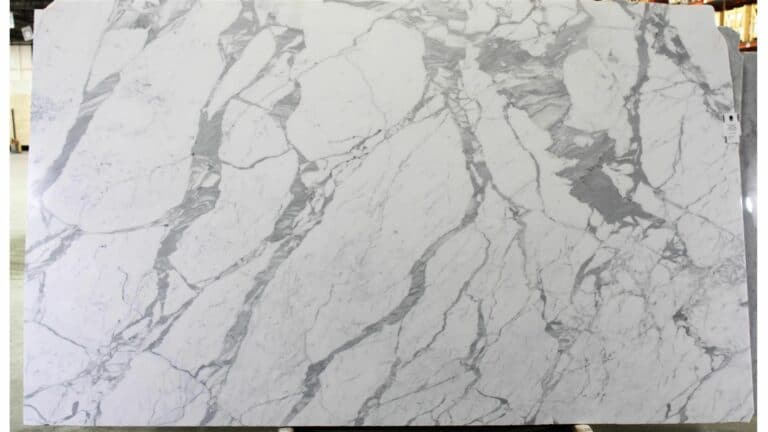
Explore the Timeless Beauty of Italian Marble
Are you an interior designer looking for the perfect Italian marble for your next project?
Are you a homeowner wanting to bring your living space to luxurious life?
Are you an architect needing a bit of inspiration to wow your client?
The Euro Marble team can help with it all and more. We would love to show you around our extensive showroom and talk all things Italian marble (and other premium stones). With a strong understanding of your preferences, budget and application, we can ensure that we find the perfect marble selection to suit your needs. Whether you’re looking for marble flooring or marble tiles for luxury bathroom vanities, feature walls, kitchens or other interior decoration applications, we can help.
Get in touch with us today or simply drop by our showroom for a visit.
For all things Italian marble, give us a call today!
We would love to show you around our extensive showroom and talk all things Italian marble.


